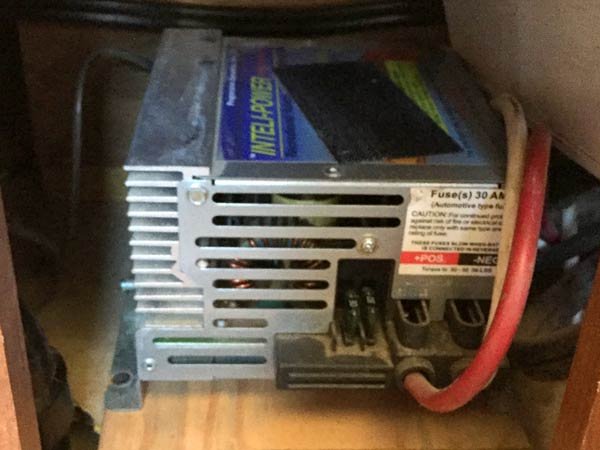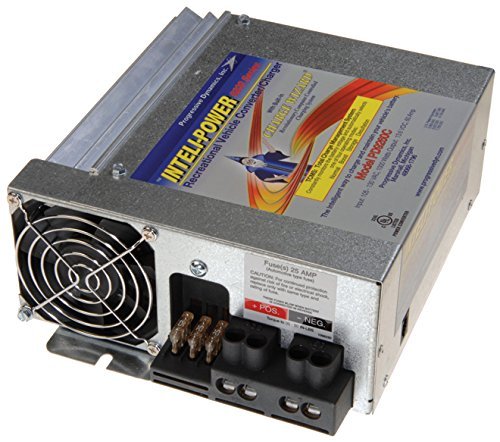If you’ve been RVing full-time for much time at all, chances are you’ve heard it. That sporadic high-pitch buzzing noise can be heard in RVs of all makes and models. If you haven’t, just wait…
I spent months trying to figure out where the whine was coming from in our 2010 Arctic Fox fifth wheel. I first noticed it a couple years after we purchased the rig used. I wouldn’t hear it for weeks, then the faint buzzing would start up infrequently again. It still doesn’t even seem to bother Rene, but she spends many of her days pounding metal on the jewelry bench I built when converting our bunkhouse RV into her workshop.
I was certain the radio caused humming sound, and figured we had a grounding issue somewhere. I was way wrong. I soon discovered that turning lights on or off would cease the noise when it got too annoying. Determined to figure out the cause, a quick search for RV humming noise led me to the answer.
What is that humming noise in your RV?
Once I read a couple articles about RV converter humming noises, the next time I heard that hum I took the vent off a cabinet that contains ours and confirmed exactly that. Our Intelli-Power Converter Charger was buzzing. Upon closer inspection, I discovered it was not the cooling fan, but a distinct electronic buzz that ceased the second I turned on an overhead light. After troubleshooting the Intelli-Power PD9200, I determined it was functioning properly, just noisy.

How to Fix RV Converter Noise
So, what is happening and what can I do about it? The noise is inherent to the design of these power converters. It’s apparently related to the operating frequency of the electronic components inside. When connected to shore power, the converter is powering your DC circuit, which powers the lighting. Loose connections and poor lamination in the transformer cores are common, and weak component mountings can also create vibration noises when there is no DC load. There are many reports from RVers who have gone through multiple converters, replacing them only to discover the next one also hummed, only at a slightly different pitch. We likely had the same issue in our previous Artic Fox, but the converter was mounted in a much less accessible location so I never noticed it.
1. The solution is simple. Live with it.
After reviewing various RVing forum discussions about converter noise, I realized this effect is quite common – with all converters, but especially aging ones – and that there is really nothing you can do about. The most simple solution is to apply load to the converter when the noise becomes bothersome. I have discovered that if the noise creeps back with lights on, turning one off will stop it again. The problem only occurs when connected to shore power, never when boondocking (since the converter is not engaged) so another option is to simply unplug.
2. Do not attempt to service your converter.
There are no user-serviceable parts inside the power converter. Attempts to repair the unit by messing around with the components inside could result in a dangerous electronic situation.

3. Replace your converter.
Typically, symptoms of a failing converter may be a loud popping noise or a puff of smoke, but they tend to go out suddenly. But if the buzzing gets too bad for you, the final option is to purchase a new power converter. Replacement seems rather simple, but we’re holding off on that – because of the evolving battery industry.
Why we’re waiting to replace our converter:
When we upgraded our RV solar power installation, lithium ion batteries were just catching on in the RV world. These would require a different type of charger/converter, so I’m not about to replace ours quite yet. But I’m gad we didn’t jump on that bandwagon too soon.
Lithium Iron Phosphate batteries will likely be the next big thing. This is the same type used in the new Dometic Power Pack and upcoming European all-electric motorhome. This new battery technology weighs less, are they are more efficient than lead acid, with a longer life expectancy, requiring less maintenance even than lithium ion batteries.
Great article. I have a 2018 Lance 1172 truck camper. At first I thought my tinnitus was getting worse and could not find the source of the noise. My wife couldn’t hear it. I got down on my hands and knees and put my ear close to the electrical panel/vent and that is where it is emanating. I have not torn into the electrical stuff to verify it is the converter but feel better knowing I am not the only one.
As soon as engine ignition switch is turned on a high pitch shrill noise starts. No internal power or generator power. Nothing is on, just engine switch. It in not gas / carbon monoxide detector. Fridgerator in off position. Just engine switch
I have my 1977 Winnebago Brave plugged into the house and after turning the main power breaker off for house repairs and then back on (I forgot about Winnie being plugged in) I now have an annoying humm and have traced it to the transformer under the bed. it stops when I unplug but I dont want to have to unplug the RV every night. Not only is it annoying, its can’t be good for the old electrical system. All electrical is currently working property, but I fear that the transformer is going out and needs to be replaced. My questions is, if I leave plugged in during the day, to charge batteries and keep the fridge running, is there a risk of fire? At this time it’s not getting hot, it’s just humming. In addition, I worry about fan noise in replacing with a new unit. The original has no fan. Can I simply replace the transformer (Or have an electrician replace the transformer?)
That’s a question for a certified electrician. We don’t say the F word around here, I say if in doubt, throw it out!
sometimes the irritating buzz/hum stops immediately with no apparent change in load, but 20 yr old fifth wheel – lol.
Likely due to DC load fluctuations…it’s always something in these older rigs!
Steve, good assessment.
Jim, I wouldn’t reccomend most people do this either.
I do electric motor maintenance and repairs (leave the rewinding to others).
I list these because some people do have the knowledge but maybe not any idea where to get the proper type of varnish.
There are clear and other colored varnishes but I like the colored ones because I can see the coverage better.
There are others but these are the ones I have used.
Good for general electrical protection of other stuff where needed.
Glyptal 1201A red insulating spray vanish ( http://www.glyptal.com/products/1201tech.pdf)
Sprayon SC0601000 EL601 Red Insulating Varnish Aerosol
CRC makes one we have in the cabinet but I have not used it yet.
If you do not have the electrical experience and knowledge to make repairs with confidence find someone that does or just replace it.
Thanks Ross! Good to know we have some tech savvy readers!
The cause of most humming in power supplies is due to the vibration of transformer core ‘laminations’ against each other. The amount of hum varies with the strength of the magnetic field being produced by electrical demanded in the equipment. Transformer cores are made of a stack of thin sheet metal stamped parts, not a single piece of solid iron. These pieces are insulated from each other by dipping them in varnish before assembly. The constant stress of the magnetic field during operation of the transformer, eventually wears the varnish down and leaves a space for the metal lamination to move, and thus ‘humming’ results. There are several rea-world solutions to the problem, each with varying degrees of longevity, effectiveness and difficulty. All methods, attempt to replace the missing varnish to eliminate the lamination’s ability to move. 1) The best is to replace the transformer with a new one. Transformers are ‘wear items’ and often sourced as commodities. You may be able to purchase the right one from an electronic component retailer. Idetifying the right one and making the swap are the challenges. 2) If you can remove the ansformer and take it to a motor rewinder, they can put it in a vacuum chamber full of varnish. Drawing a vacuum infuses varnish into the spaces, returning the transformer to nearly ‘as manufactured’ condition. 3) Since this is likely challenging on several levels, a handy DIY’er can attempt the same thing, without vacuum, using a highly thinned shellac. 4) Lastly, it may be possible to apply cyanoacrylate (super glue) to the edges of an, in-situ, warm transformer with the hope that capilary attraction will draw adhesive in.
Thanks for the much more detailed explanation Steve. I’m just not about to recommend the average RVer take on such a level of electronic component repair here since doing an improper job could cause much more harm than good!
Steve, good assessment.
Jim, I wouldn’t reccomend most people do this either.
I do electric motor maintenance and repairs (leave the rewinding to others).
I list these because some people do have the knowledge but maybe not any idea where to get the proper type of varnish.
Glyptal and Sprayon both make a red insulating varnish for windings.
Good for general electrical protection of other stuff where needed.
Glyptal 1201A red insulating spray vanish ( http://www.glyptal.com/products/1201tech.pdf)
Sprayon SC0601000 EL601 Red Insulating Varnish Aerosol
If you do not have the electrical experience and knowledge to make repairs with confidence find someone that does or just replace it.